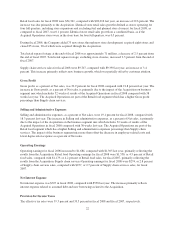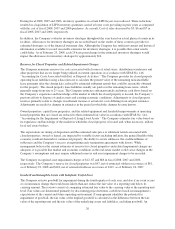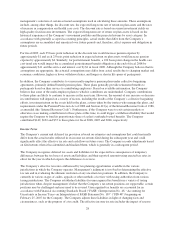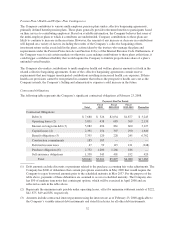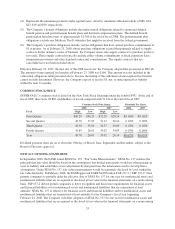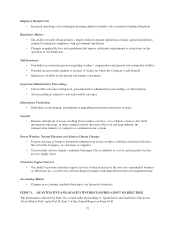Albertsons 2008 Annual Report Download - page 35
Download and view the complete annual report
Please find page 35 of the 2008 Albertsons annual report below. You can navigate through the pages in the report by either clicking on the pages listed below, or by using the keyword search tool below to find specific information within the annual report.provisions and changes to those reserves. The Company also provides interest on these reserves at the appropriate
statutory interest rate. The actual benefits ultimately realized for tax positions may differ from the Company’s
estimates due to changes in facts, circumstances and new information. As of February 23, 2008 and February 25,
2007, the Company had $146 and $312 of unrecognized tax benefits, respectively.
The Company records a valuation allowance to reduce the deferred tax assets to the amount that it is more-likely-
than-not to realize. Forecasted earnings, future taxable income and future prudent and feasible tax planning
strategies are considered in determining the need for a valuation allowance. In the event the Company was not
able to realize all or part of its net deferred tax assets in the future, the valuation allowance would be increased.
Likewise, if it was determined that the Company was more-likely-than-not to realize the net deferred tax assets,
the applicable portion of the valuation allowance would reverse. The Company had a valuation allowance of
$147 and $175 as of February 23, 2008 and February 24, 2007, respectively.
LIQUIDITY AND CAPITAL RESOURCES
Net cash provided by operating activities was $1,732, $801 and $695 in fiscal 2008, 2007 and 2006, respectively.
The increase in cash from operating activities in fiscal 2008 compared to fiscal 2007 and fiscal 2007 compared to
fiscal 2006 is primarily attributable to the impact of the Acquired Operations on Net earnings, Depreciation and
amortization and working capital.
Net cash used in investing activities was $968, $2,760 and $258 in fiscal 2008, 2007 and 2006, respectively.
Fiscal 2008 investing activities primarily reflect capital spending to fund retail store remodeling and new stores.
Fiscal 2007 investing activities primarily reflect the net assets acquired in the Acquisition and capital spending to
fund retail store remodeling and new stores. Fiscal 2006 investing activities primarily reflect capital spending to
fund new stores, store remodeling, technology enhancements and supply chain growth initiatives.
Net cash (used in) provided by financing activities was $(806), $1,443 and $(193) in fiscal 2008, 2007 and 2006,
respectively. Fiscal 2008 financing activities primarily reflect repayments of long-term debt, payment of
dividends and purchases of treasury shares offset by proceeds received from the sale of common stock under the
Company’s stock option plans. Fiscal 2007 financing activities primarily reflect the debt incurred in connection
with the Acquisition and senior notes issued in October 2006, partially offset by repayment of long-term debt of
Albertsons standalone drug business payables related to the sale of Albertsons. Fiscal 2006 financing activities
primarily reflect the repayments of long-term debt, the payment of dividends and the purchase of treasury shares
offset by proceeds received from the sale of common stock under the Company’s stock option plans.
Management expects that the Company will continue to invest in capital expenditures with internally generated
funds. However, there can be no assurance that the Company’s business will continue to generate cash flow at
current levels. The Company will continue to obtain short-term financing from its credit facilities. Long-term
financing will be maintained through existing and new debt issuances. The Company’s short-term and long-term
financing abilities are believed to be adequate as a supplement to internally generated cash flows to fund its
capital expenditures and acquisitions as opportunities arise. Maturities of debt issued will depend on
management’s views with respect to the relative attractiveness of interest rates at the time of issuance and other
debt maturities.
Certain of the Company’s credit facilities and long-term debt agreements have restrictive covenants and cross-
default provisions which generally provide, subject to the Company’s right to cure, for the acceleration of
payments due in the event of a breach of the covenant or a default in the payment of a specified amount of
indebtedness due under certain other debt agreements. The Company was in compliance with all such covenants
and provisions for all periods presented.
On June 1, 2006, the Company executed senior secured credit facilities in the amount of $4,000. These facilities
were provided by a group of lenders and consist of a $2,000 five-year revolving credit facility (the “Revolving
29





